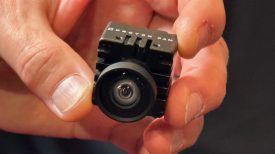
At the SMPTE (Society of Motion Pictures and Television Engineers) conference in Los Angeles underway this week, Josef Marc, Co-founder & CMO of Archimedia Technology, will present a paper that challenges current perception of what the phrase ‘broadcast quality’ means. This is a very interesting and highly relevant topic given the quality of not only today’s professional cameras, but also those of consumer cameras and smart phones. Broadcast standards need to adapt and move with the times as most of them were created long before the introduction of today’s modern cameras.
Most countries around the world use one of three main video broadcast standards – NTSC, PAL or SECAM. The first colour TV broadcast system was implemented in the United States in 1953, based on the NTSC – National Television System Committee standard. This specification became a de facto broadcast standard. But since then, with continuing improvements in camera image sensors, increased resolution, different recording media and better codecs, the line between what is broadcast quality and what isn’t has become blurred.
In the paper he will present at SMPTE, Josef Marc says, ‘Broadcast quality’ is now being determined by the viewer, not broadcasters. Broadcast quality, which has traditionally been a standard that television engineers have strived to achieve, is being superseded by the choices of consumers in their devices. According to Marc, In the early days of television the advertising community needed a standard for ‘broadcast quality’ so they could be sure their commercials were seen in the best possible light. Standards bodies like SMPTE and NTSC helped define what the viewers would see. After a TV commercial ran, broadcasters had to send advertisers a record of when an ad ran, as well as TV technical specs that were achieved. If the specs were not ‘broadcast quality,’ the advertiser might not pay. He now says that model no longer applies. Consumers don’t care if it’s right, they care how it makes them feel. Advertisers and subscription services will compete to satisfy them. Today smart television sets have powerful controls over what the consumer sees, so ‘broadcast quality’ is now more in the hands of the consumers than broadcasters. The driver of this change is the growing sophistication of today’s smart TV sets which offer a wide variety of “modes” to shape the viewer’s experience. From the technical view, these modes are complex algorithms combining a variety of visual and aural characteristics, including contrast, brightness, edge enhancements, color range, audio processing, motion blur repair, and even upscaling normal High Definition to Ultra High Definition and High Dynamic Range. Once a consumer engages a mode, a wide variety of technical adjustments take place that shapes what the consumer experiences. When looked at from this point of view, the viewer experience is no longer shaped by a standard that is adhered to at the point of broadcast but by the powerful digital processing within today’s smart TV sets, smart phones, smart tablets, and smart personal computers.
We have all seen TV news broadcasts where they use amateur vision from a cell phone or a live Skype interview. Broadcasters have strict requirements for deliverable material to be captured at a certain specification, but there have always been exceptions to the rules, particularly when it comes to broadcast news. For many years broadcasters like the BBC have had strict guidelines for delivery of television programmes, the basis on what is deemed to be ‘broadcast quality.’ They even have a 41-page document online that outlines all these requirements – below you can read the specs for picture quality.
1.1 Picture Quality
The picture must be well lit and reasonably but not artificially sharp.
The picture must be free of excessive noise, grain and digital compression artefacts.
The picture must be free of excessive flare, reflections, lens dirt, markings and obstructions (e.g. lens hood), and lens aberrations.
Movement must appear reasonably smooth and continuous, and must not give rise to distortions or break-up to moving objects, or cause large changes in resolution.
The picture must be free of excessive black crushing and highlight compression. Hard clipping of highlights (e.g. by legalisers) must not cause visible artefacts on screen.
There must be no noticeable horizontal or vertical aliasing, i.e. jagged lines, field or frame rate fluctuations in fine detail.
Colour rendition, especially skin tones, must be consistent throughout, and a realistic representation of the scene portrayed unless it is altered as an editorially essential visual effect.
The picture must be stable and continuous – i.e. no jumps, movements, shifts in level or position.
There must be no visible contouring / artefacts caused by digital processing. Quantisation noise must not be apparent.
There must be no noticeable spurious signals or artefacts e.g. streaking, ringing, smear, echoes, overshoots moiré, hum, cross-talk etc.
2.1 High Definition Format
All material delivered for UK HD TV transmission must be:
1920 x 1080 pixels in an aspect ratio of 16:9
25 frames per second (50 fields) interlaced – now known as 1080i/25.
colour sub-sampled at a ratio of 4:2:2
The HD format is fully specified in ITU-R BT.709-5 Part 2.
2.3 Video Levels and Gamut (illegal signals)
High Definition digital signals will be assessed according to the recommendation ITU-R BT709-5 Part 2.
Video levels must be received within the specified limits so that the programme material can be used without adjustment. Any signal outside the specified limits is described as a gamut error.
2.7 Use of Non-HD material
Some high definition programmes will contain some material from standard definition originals, and sources which are not considered to meet HD broadcast standards, such as domestic camcorders. This material is all called ‘non-HD’ in this document.
To maintain a high standard and meet audience expectations the amount of non-HD material is limited to 25% of the programme’s total duration. Non-HD material must not be used for large uninterrupted sections of the programme, unless agreed by the broadcaster. This includes archive material.
2.7.1 Non-HD material
Material acquired using the following methods or formats is considered to be below the high definition standard and will therefore be treated as non-HD:
HDV from all manufactures
Most cameras with image sensors under 1⁄2”
Frame based (intra-frame) recording formats below 100Mb/s
Inter-frame based recording formats below 50Mb/s
Material generated or processed on 720 line equipment
I’m not going to argue for one second that there shouldn’t be standards, but they should be judged by what the viewer finds acceptable. Many of todays cameras feature very efficient codecs and often record in colour sub-sampling of 4:2:0. For most broadcasters any material captured on one of these cameras would be deemed not good enough for broadcast. The strange thing is more and more viewers are watching their content online and not via traditional TV broadcasting. The files that are streamed or uploaded to the web are often so highly compressed that the original quality of the material when it was captured will not be seen by the audience. Again I’m not saying that broadcasters should just put anything up without quality control, but they need to look more closely at what is acceptable. It will be very interesting to see the feedback from Josef Marc’s paper once it has been read at SMPTE. In my opinion the definition of what ‘broadcast quality’ actually means needs to be changed – just as the cameras and equipment we use continue to evolve, so should the definition.





